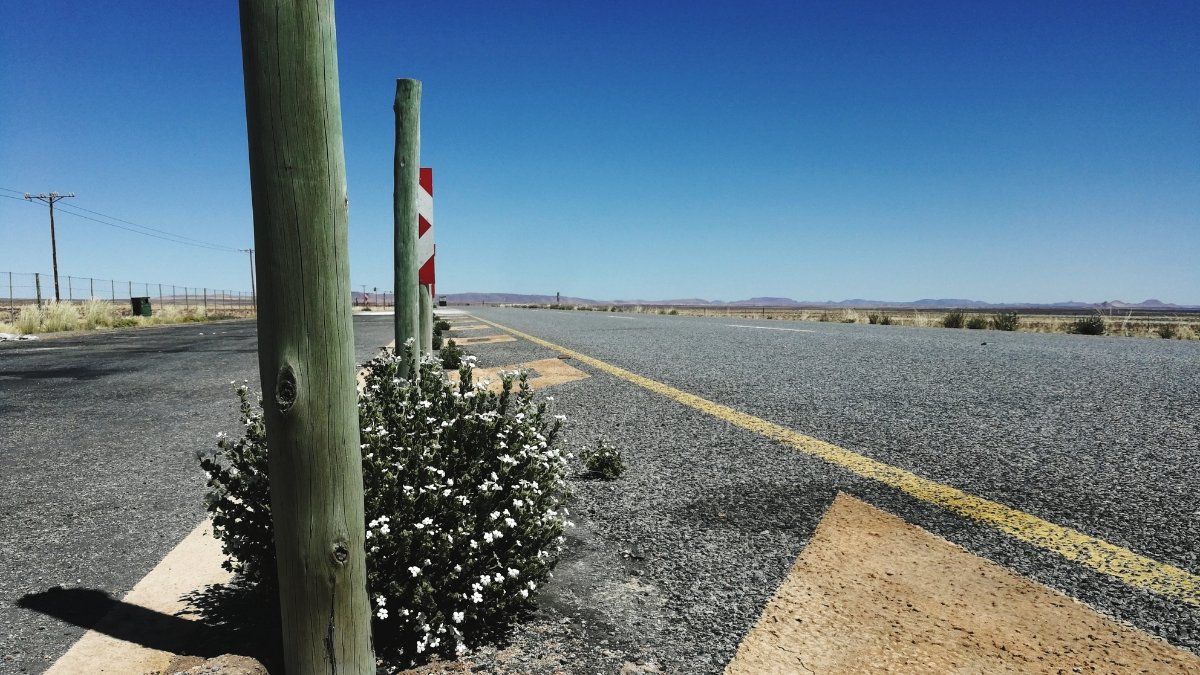Tired of monotonous highways and predictable pit stops? Longing for a road trip that sparks curiosity and excitement? Discover 15 of the USA’s most bizarre roadside attractions that promise to transform your journey into an unforgettable adventure.
From a colossal blue whale in Oklahoma to a house built entirely of beer bottles in Nevada, these quirky landmarks offer more than just a break from driving—they provide stories and memories to last a lifetime. Buckle up and prepare to explore the unexpected wonders that await on America’s open roads.
#1. The World’s Largest Basket
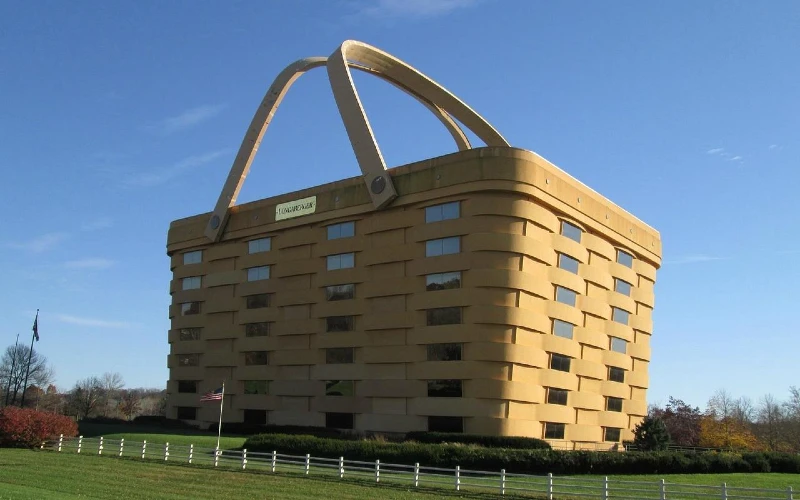
In Newark, Ohio, stands a seven-story building shaped like a colossal picnic basket. This structure was originally the headquarters of the Longaberger Company, known for its handcrafted baskets.
Completed in 1997, the building replicates the company’s Medium Market Basket design, complete with two massive handles weighing 150 tons each.This architectural choice was a bold marketing strategy, aiming to embody the brand’s identity in a tangible form.
Although the company vacated the premises in 2016, the basket building remains a symbol of innovative design and a testament to the company’s legacy. Its unique appearance continues to attract visitors, reflecting the impact of creative architecture on local tourism.
#2. The Giant Orange of Melbourne
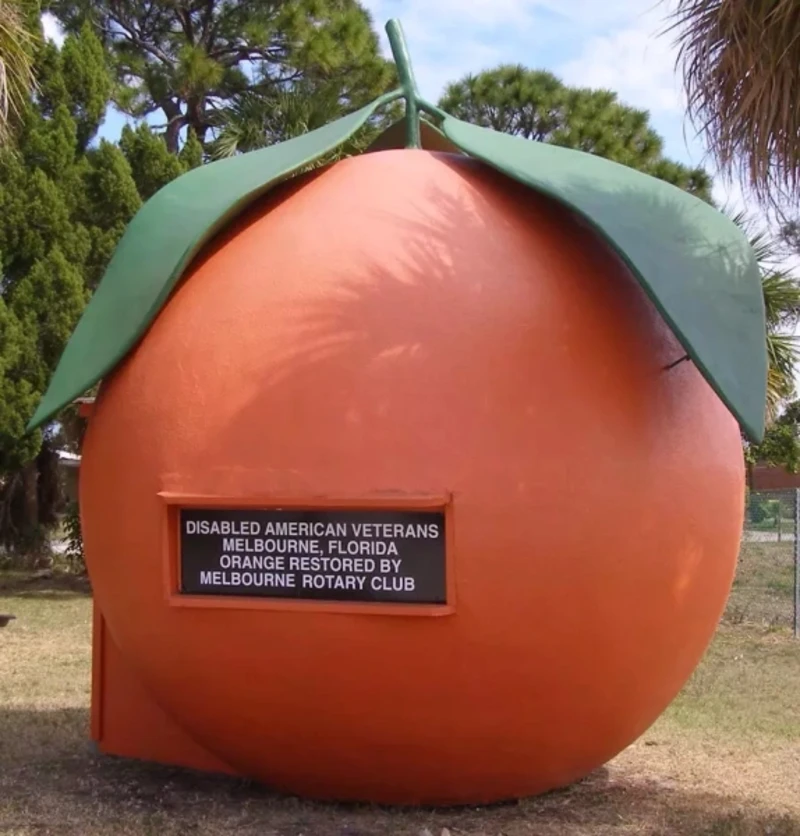
In Melbourne, Florida, travelers can spot a building shaped like a giant orange. This whimsical structure pays homage to Florida’s rich citrus industry, which has been a significant part of the state’s economy and cultural identity.
Such novelty architecture serves as a roadside attraction and a nod to the region’s agricultural heritage. These eye-catching designs were popular in the mid-20th century, intended to lure motorists to stop and purchase fresh citrus products.
Today, the Giant Orange stands as a nostalgic reminder of this marketing trend, offering a glimpse into the past and the enduring appeal of themed architecture in American culture.
#3. An Unusual Amish Horse and Buggy ATM

In Ohio’s Amish Country, near the town of Mesopotamia, there’s a distinctive ATM designed to resemble a traditional Amish horse and buggy. This creative structure reflects the region’s Amish heritage, where horse-drawn buggies are a common sight.
The ATM serves a practical purpose while also acting as a tourist attraction, blending modern banking convenience with cultural symbolism. It highlights the community’s respect for tradition alongside the integration of necessary modern amenities.
Visitors often find this fusion of old and new intriguing, making the ATM a popular photo opportunity and a testament to the area’s unique cultural landscape.
#4. Wind Turbine Blade in Weatherford

In Weatherford, Oklahoma, a massive wind turbine blade is displayed in a city park. This impressive piece showcases the scale of renewable energy technology. Wind turbines play a crucial role in sustainable energy production, and seeing a blade up close allows visitors to appreciate the engineering involved.
The exhibit serves an educational purpose, promoting awareness of alternative energy sources and their importance in reducing carbon footprints. By presenting such technology in a public space, Weatherford emphasizes its commitment to sustainability and provides an informative stop for travelers interested in the mechanics of wind energy.
#5. Apple Boulders of Perris

Near Perris, California, along the highway, travelers can observe large boulders painted to resemble apples. This roadside art installation adds a touch of whimsy to the landscape, capturing the attention of passersby.
Such creative expressions contribute to the local culture, turning ordinary natural features into points of interest. The apple boulders may also reflect the area’s agricultural connections, subtly highlighting the significance of fruit farming in the region.
These artistic endeavors enhance the travel experience, offering unexpected delights and encouraging appreciation for local creativity and the blending of art with the natural environment.
#6. The Leaning Water Tower Roadside
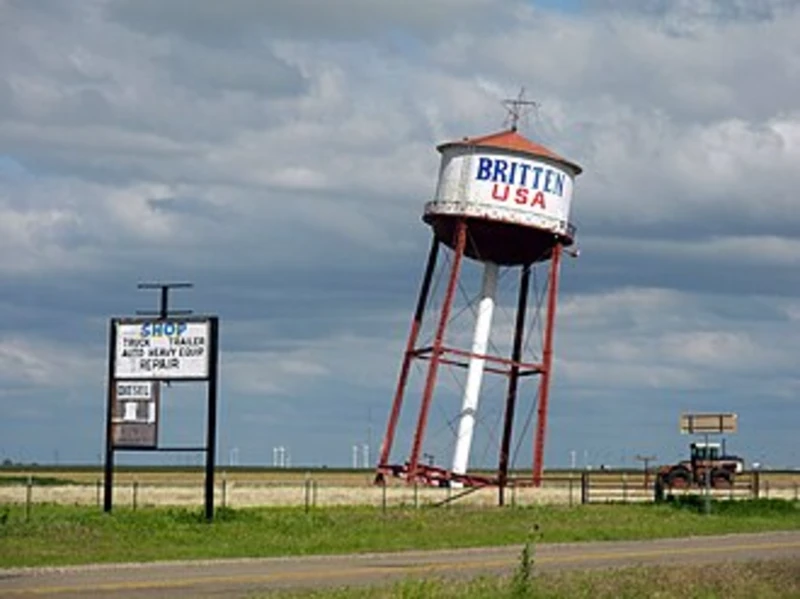
In Groom, Texas, a peculiar sight awaits travelers: a water tower leaning at a noticeable angle. This structure, known as the Leaning Tower of Texas, was purchased by Ralph Britten around 1980.
Originally intended to supply water to his truck stop, Britten decided to tilt the tower deliberately, creating a unique landmark to attract visitors. The tower leans at approximately 10 degrees, giving the illusion of impending collapse, yet it remains securely anchored. This intentional tilt serves as a marketing strategy, drawing attention from passersby on Route 66 and Interstate 40.
Over time, the Leaning Tower has become a symbol of the town, embodying the spirit of roadside Americana and the creativity employed by entrepreneurs to stand out in the vast Texas landscape.
#7. The Big Shoe Repair Shop
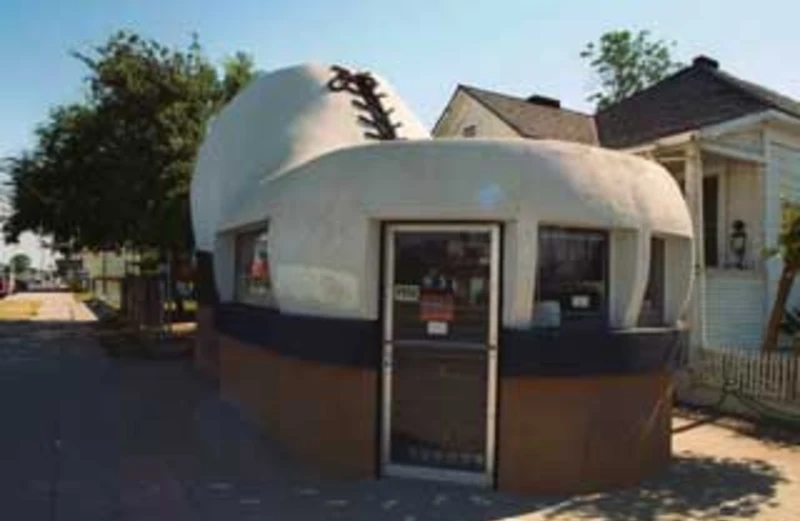
In Bakersfield, California, stands a building shaped like a giant shoe, housing the Big Shoe Repair Shop. Constructed in 1947 by the Deschwanden family, this 30-foot-long and 20-foot-high structure resembles a classic low-top shoe, complete with a 50-foot-long black shoelace made of rope.
The unique design was intended to catch the eye of motorists and pedestrians, serving as both a functional business and an advertisement. Over the years, the Big Shoe has become a local landmark, symbolizing the era’s novelty architecture aimed at attracting customers through whimsical designs.
Despite changes in ownership and periods of closure, the building’s distinctive appearance continues to charm visitors, reflecting a nostalgic piece of mid-20th-century Americana.
#8. The World’s Largest Fire Hydrant

In Columbia, South Carolina, an enormous fire hydrant sculpture, known as “Busted Plug Plaza,” stands over 40 feet tall. Created by local artist Blue Sky and installed in 2001, this massive structure weighs more than 675,000 pounds.
The artist designed it to appear as if it had been dislodged from the ground, tilting at an angle with water gushing from its base. This visual effect challenges perceptions and adds an element of surprise.
The hydrant’s exaggerated size and dynamic presentation make it a striking piece of public art, attracting tourists and art enthusiasts alike. Its presence in downtown Columbia contributes to the city’s cultural landscape, showcasing the impact of large-scale sculptures in urban environments.
#9. The Giant Dancing Hares of Dublin
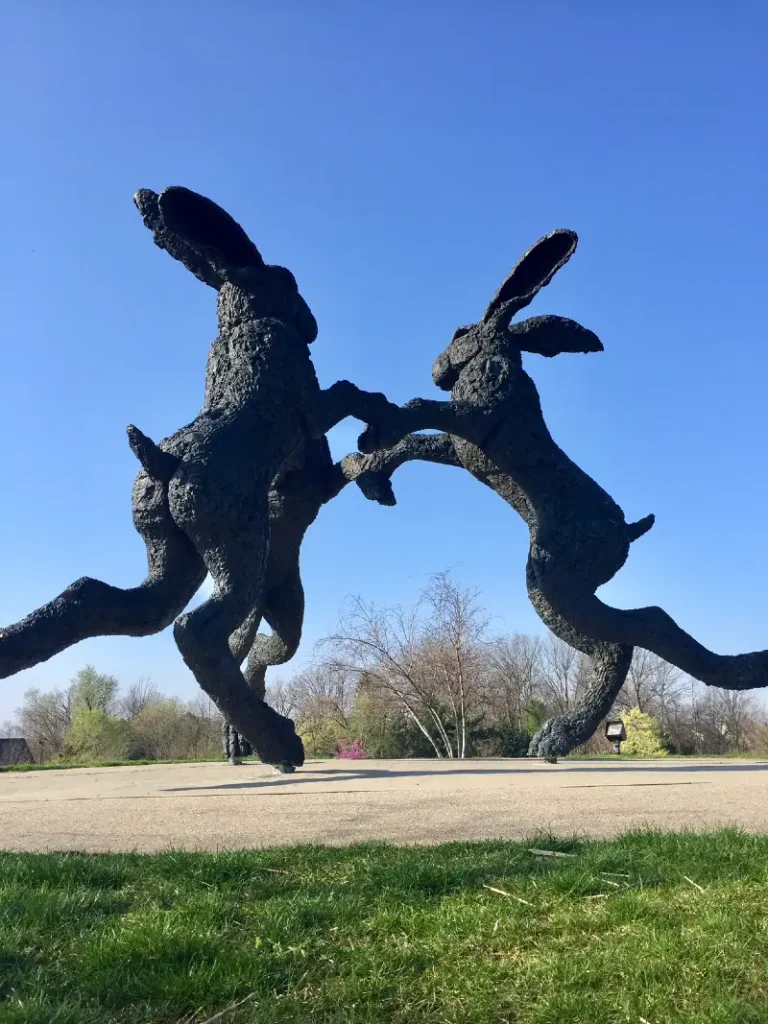
In Dublin, Ohio, atop a hill in Ballantrae Park, three towering bronze sculptures depict hares engaged in a whimsical dance. Created by British artist Sophie Ryder and installed in 2001, each hare stands up to 24 feet tall.
The sculptures capture the playful essence of hares during their springtime courtship rituals, known as “boxing.” Ryder’s work often explores animal forms to convey human emotions, and the Dancing Hares are no exception.
Their placement in a public park encourages interaction, inviting visitors to explore the space and engage with the art. The installation has become a beloved landmark, enhancing the community’s appreciation for public art and adding a touch of enchantment to the local landscape.
#10. Field of Corn

In Dublin, Ohio, an unusual art installation known as “Field of Corn (with Osage Oranges)” features 109 concrete ears of corn, each standing 6 feet 3 inches tall. Created by artist Malcolm Cochran and dedicated in 1994, the installation occupies a former cornfield, paying homage to the area’s agricultural heritage.
The oversized corn sculptures are arranged in precise rows, mimicking the layout of a traditional cornfield. This tribute honors Sam Frantz, a local farmer and inventor of hybrid corn species, acknowledging his contributions to agricultural innovation.
While initially met with mixed reactions, the Field of Corn has become a celebrated landmark, blending art with local history and sparking conversations about the evolution of the landscape from rural farmland to suburban development.
#11. Find the World’s Largest Drumsticks
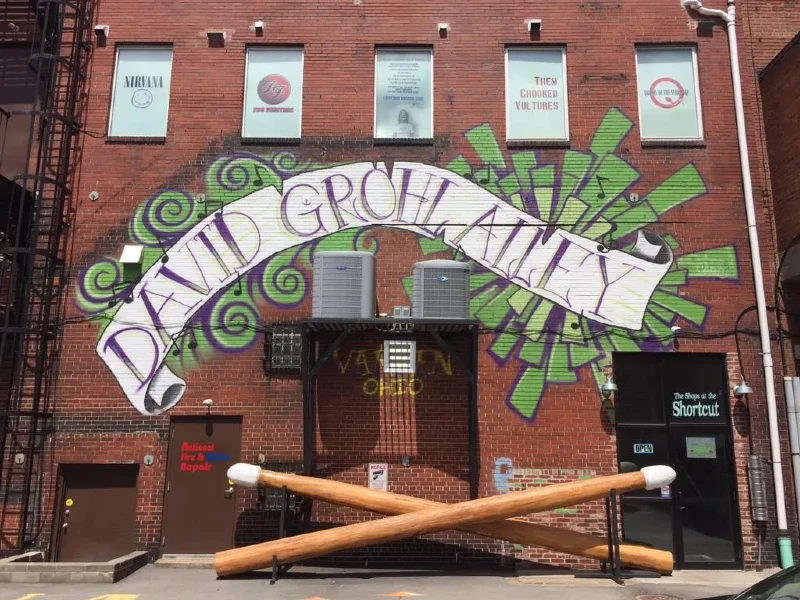
In Warren, Ohio, an alley dedicated to musician David Grohl, founder of the Foo Fighters and former drummer for Nirvana, features the world’s largest drumsticks. Each drumstick, carved from a single poplar log, measures approximately 23 feet in length and weighs 900 pounds.
Installed in 2012, these colossal instruments pay tribute to Grohl’s musical achievements and his connection to his hometown. The drumsticks are part of David Grohl Alley, which also showcases murals and artworks celebrating his career.
This creative space has revitalized the area, attracting fans and tourists, and highlighting the influence of local figures on community identity. The installation exemplifies how public art can honor notable individuals while fostering local pride and cultural engagement.
#12. The Blue Whale of Catoosa on Route 66

In Catoosa, Oklahoma, along the historic Route 66, stands the Blue Whale—a whimsical structure that has charmed visitors for decades. Constructed in the early 1970s by Hugh S.
Davis, a local zoologist, the 80-foot-long whale was initially a surprise anniversary gift for his wife, Zelta. Davis envisioned it as a play structure for their grandchildren, complete with a pond for swimming. Over time, the Blue Whale became a popular stop for travelers journeying along Route 66. Its friendly appearance and accessible location made it an inviting spot for families to relax and enjoy the surroundings. After Davis’s passing in 1990, the attraction faced periods of neglect.
However, community efforts in the 1990s and beyond led to its restoration, preserving this piece of Americana. Today, the Blue Whale remains a symbol of creativity and nostalgia, embodying the spirit of Route 66 and the personal stories that contribute to its rich history.
#13. The Smallest Church in America

Nestled near Townsend, Georgia, Christ’s Chapel in Memory Park claims the title of the “Smallest Church in America.” Built in 1949 by Agnes Harper, this tiny sanctuary measures a mere 10 by 15 feet, accommodating about a dozen people.
Harper intended the chapel as a spiritual haven open to travelers of all faiths, providing a place for reflection and prayer. Over the years, the church has attracted numerous visitors seeking solace or simply curious about its diminutive size. In 2015, the chapel suffered significant damage due to arson.
The local community rallied to rebuild it, demonstrating the deep connection and value placed on this modest structure. Today, the restored chapel continues to serve as a peaceful stop for passersby, embodying the enduring spirit of hospitality and faith along Georgia’s highways.
#14. Beer Bottle House in Death Valley

In the ghost town of Rhyolite, Nevada, near Death Valley, stands Tom Kelly’s Bottle House—a testament to resourceful construction during the early 20th century. Built in 1906 by Tom Kelly, an Australian-born stonemason turned gold miner, the house comprises over 50,000 glass bottles, primarily from beer and liquor, mortared together with adobe.
During Rhyolite’s boom, traditional building materials were scarce and costly, prompting Kelly to utilize the abundant discarded bottles from the town’s numerous saloons. The three-room structure featured plastered interior walls, providing insulation suitable for the desert climate. Kelly raffled off the house, and it changed hands several times as Rhyolite transitioned into a ghost town.
In the 1920s, the house was restored by Paramount Pictures for use as a filming location, preserving its unique architecture. Today, the Bottle House stands as a historical landmark, reflecting the ingenuity of early settlers and the ephemeral nature of boomtowns in the American West.
#15. The World’s Largest Bat

In Louisville, Kentucky, the Louisville Slugger Museum & Factory proudly displays the world’s largest baseball bat. This colossal replica of Babe Ruth’s Louisville Slugger bat stands 120 feet tall and weighs 34 tons.
Crafted from hollow carbon steel, the bat leans against the museum building, creating an iconic image that draws baseball enthusiasts and tourists alike. Installed in 1996, the bat symbolizes Louisville’s rich baseball heritage and the craftsmanship behind the famous Louisville Slugger brand.
Visitors to the museum can explore the history of baseball bat manufacturing, witness the production process, and even hold bats used by legendary players. The giant bat serves not only as a marketing landmark but also as a tribute to the sport’s enduring legacy in American culture.

